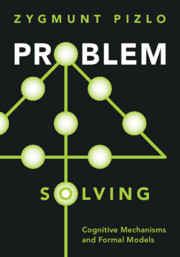Book contents
- Problem Solving
- Problem Solving
- Copyright page
- Dedication
- Contents
- Figures
- Tables
- Preface
- Chapter 1 Problem Solving
- Chapter 2 Animal Problem Solving
- Chapter 3 Modern Research on the Human Ability to Solve Problems that Have Large Search Spaces
- Chapter 4 The Exponential Pyramid Representation that Compensates for Exponentially Large Problem Spaces
- Chapter 5 Heuristic Function, Distance, and Direction in Solving Problems
- Chapter 6 Insight and Creative Thinking
- Chapter 7 Inference in Perception
- Chapter 8 Cognitive Inferences, Mental Representations
- Chapter 9 Theory of Mind
- Chapter 10 Solving Problems in Physics and Mathematics
- Chapter 11 Summary and Conclusions
- References
- Index
Chapter 5 - Heuristic Function, Distance, and Direction in Solving Problems
Published online by Cambridge University Press: 23 June 2022
- Problem Solving
- Problem Solving
- Copyright page
- Dedication
- Contents
- Figures
- Tables
- Preface
- Chapter 1 Problem Solving
- Chapter 2 Animal Problem Solving
- Chapter 3 Modern Research on the Human Ability to Solve Problems that Have Large Search Spaces
- Chapter 4 The Exponential Pyramid Representation that Compensates for Exponentially Large Problem Spaces
- Chapter 5 Heuristic Function, Distance, and Direction in Solving Problems
- Chapter 6 Insight and Creative Thinking
- Chapter 7 Inference in Perception
- Chapter 8 Cognitive Inferences, Mental Representations
- Chapter 9 Theory of Mind
- Chapter 10 Solving Problems in Physics and Mathematics
- Chapter 11 Summary and Conclusions
- References
- Index
Summary
The 15-puzzle is another well-known and well-studied problem with a large search space that is quickly solved by humans. This chapter defines the concept called the parity of a state of the 15-puzzle that is invariant for legal moves. From here on, the reader will see the terms invariance and symmetry showing up frequently in our discussion of problem solving. This should be rather intriguing because this concept has been completely absent from all prior research on human and computer problem solving. Next, the formal concept of a heuristic is introduced as an estimated distance to a goal. The second half of the chapter describes one of the few, perhaps even the only study of human performance in solving the 15-puzzle. Humans transform the start state to the goal state quickly and avoid backtracking. This way of solving the 15-puzzle strongly suggests that humans use direction, rather than distance. These two concepts are well defined in metric spaces, such as the Euclidean space that we use to describe our familiar physical environment. Here, I point out that in spaces, other than Euclidean, direction generalizes into what is known as a geodesic. This is important because it provides suggestions for how human problem solving could, or should, be studied in the future. The chapter ends with a description of a pyramid model that emulates how humans solve the 15-puzzle by using direction.
Keywords
- Type
- Chapter
- Information
- Problem SolvingCognitive Mechanisms and Formal Models, pp. 80 - 93Publisher: Cambridge University PressPrint publication year: 2022



